New Impact Studies Show Carnegie Math Pathways Students Outperform Their Peers
April 10, 2017
Higher Completion and Transfer Rates
STANFORD, CALIF – New impact studies show that college students enrolled in Statway® and Quantway® — two accelerated development math programs in the Carnegie Math Pathways™ initiative — transfer from two-year to four-year colleges at higher rates, 43-to-46 percent, than all community college students nationwide, whose transfer rate is 32 percent [See Tables B & D]. These differences are especially remarkable in that Pathways courses service students with weak academic backgrounds at entry to community college. In the past, these students would be less likely than other students to succeed, but with Pathways courses they are now considerably more successful than even the average community college student.
Additionally, Statway and Quantway students have triple and double the success rates in completing college-level math credit and developmental math sequences, respectively, and do so in half the time. These rates have held even as program enrollment has quadrupled since being launched five years ago. [See Tables A & C].
Nationally, about 60 percent of first-time community college freshmen are assigned to developmental math each year because they’re not prepared for college-level work. Only 20 percent of these students successfully complete their remedial requirements and a college-level math class within three years, according to the Community College Research Center. The thousands of students who don’t make it through a college math class are shut out of earning associate degrees, transferring to four-year colleges, or enrolling in many specialized certification programs.
To address this problem, the Carnegie Foundation assembled a network of college math instructors, academic researchers, and administrators, who used the six core principles of improvement, an evidence-based, user-focused process, to design Pathways. The work is ongoing, as the network continues to iterate and test new improvements in teaching developmental math.
“These students are no longer denied an opportunity for a better life,” said Karon Klipple, executive director of Carnegie Math Pathways, adding that these gains are across the board for students of all ethnic and racial backgrounds, as well as both male and female students.
About Carnegie
The Carnegie Foundation for the Advancement of Teaching is committed to developing networks of ideas, individuals, and institutions to advance teaching and learning. We join together scholars, practitioners, and designers in new ways to solve problems of educational practice. Toward this end, we work to integrate the discipline of improvement science into education with the goal of building the field’s capacity to improve.
Appendix
STATWAY OUTCOMES
- Statway is structured so that developmental math students can earn college math credit in a single academic year instead of the longer traditional sequence, saving students—and colleges—time and money.
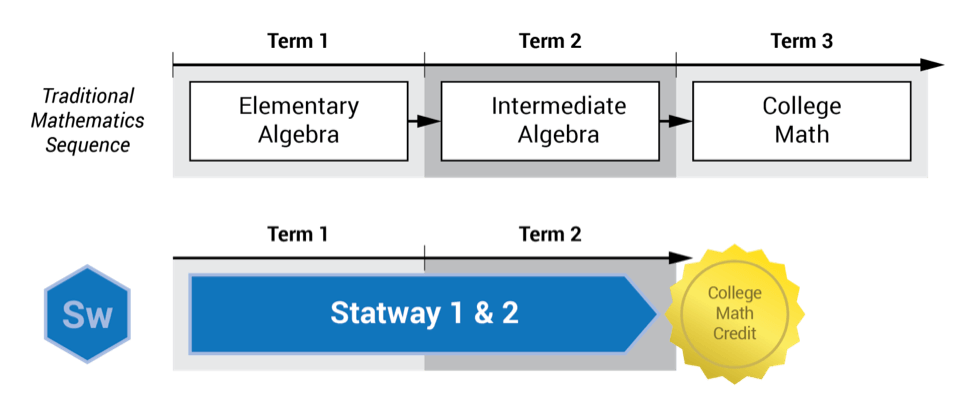
- TABLE A: Statway Completion Rates
Statway students achieve triple the success in half the time. In 2015-16, 50% of Statway students successfully complete college math credit in a single year compared to only 16% of students in traditional development math in two years.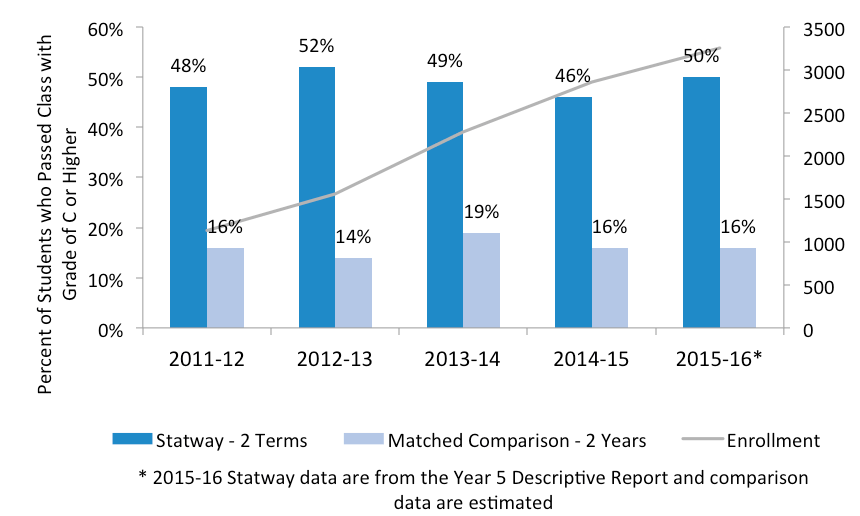
Results based on analysis done for Yamada, H., & Bryk, A. S. (2016). Assessing the first two years’ effectiveness of Statway®: A multilevel model with propensity score matching. Community College Review, 44, 179-204; Huang, M., & Yamada, H. (2017). Maintaining success rates: Does Statway® sustain its impact as it scales to new classrooms and institutions? Stanford, CA: Carnegie Foundation for the Advancement of Teaching; and Hoang, H., Huang, M., Yesilyurt, S., & Yamada, H. (2017). Carnegie Math Pathways: 2015-2016 Impact Report – A Five Year Review. Stanford, CA: Carnegie Foundation for the Advancement of Teaching.
- TABLE B: Statway 2-to-4-Year College Transfer Rates
43% of Statway students transfer from community college to four-year institutions within 5 years. By comparison, 32% of all community college students nationwide transfer to four-year institutions within 6 years.STATWAY STUDENTS ARE MORE LIKELY TO TRANSFER TO 4-YEAR COLLEGES COMPARED TO ALL COMMUNITY COLLEGE STUDENTS NATIONWIDE.
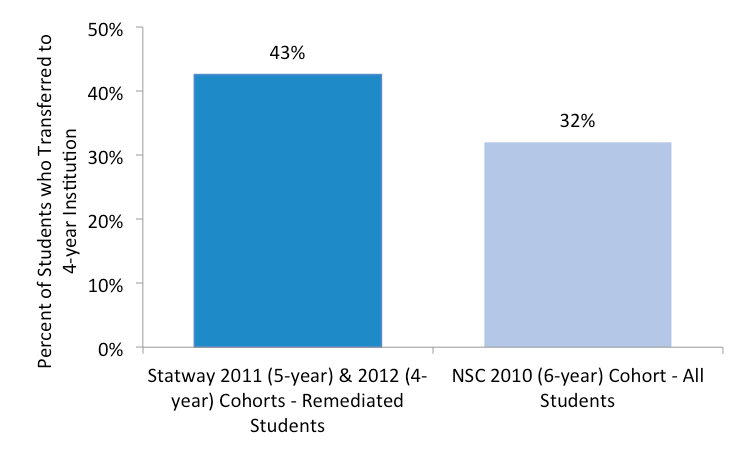
Norman, J. (2017). Pathways Post-Participation Outcomes: Preliminary Findings. Stanford, CA: Carnegie Foundation for the Advancement of Teaching.
QUANTWAY OUTCOMES
- Quantway 1 is designed to accelerate the progress of college students through developmental mathematics in a single term rather than the longer traditional sequence, by increasing success rates and helping more students get to and through their college credit in mathematics.
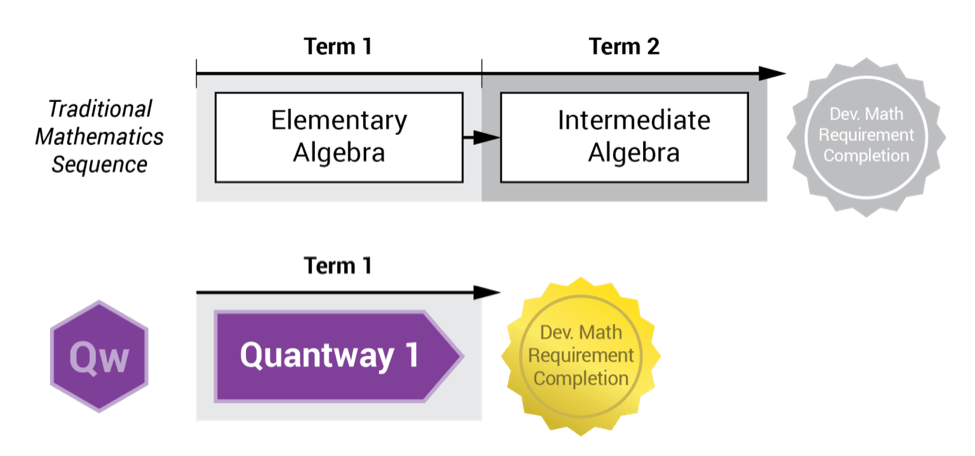
- TABLE C: Quantway Success Rates
64% of Quantway 1 students successfully complete their developmental math coursework in one term (semester or quarter), while only 37% of their peers in a traditional developmental math sequence succeed after an entire academic year.
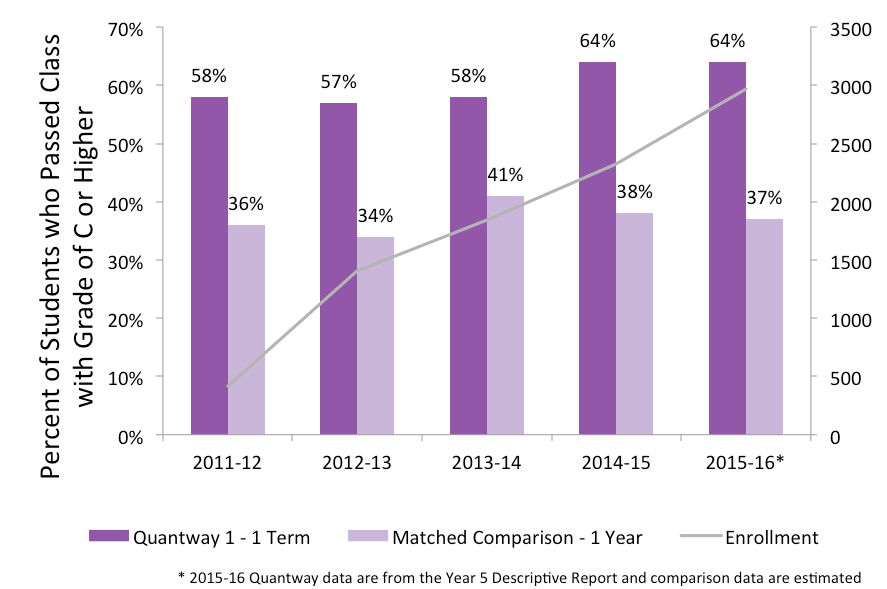
Results based on analysis done for Yamada, H. (2017). Do effects of Quantway® persist in the following year?: A multilevel propensity score approach to assessing student college mathematics achievement. Stanford, CA: Carnegie Foundation for the Advancement of Teaching; and Hoang, H., Huang, M., Yesilyurt, S., & Yamada, H. (2017). Carnegie Math Pathways: 2015-2016 Impact Report – A Five Year Review. Stanford, CA: Carnegie Foundation for the Advancement of Teaching.
- TABLE D: Quantway 2-to-4-Year College Transfer Rates
46% of Quantway 1 students transfer from community college to four-year institutions within 5 years. By comparison, 32% of all community college students nationwide transfer to four-year institutions within 6 years.
QUANTWAY STUDENTS ARE MORE LIKELY TO TRANSER TO 4-YEAR COLLEGES COMPARED TO ALL COMMUNITY COLLEGE STUDENTS NATIONWIDE.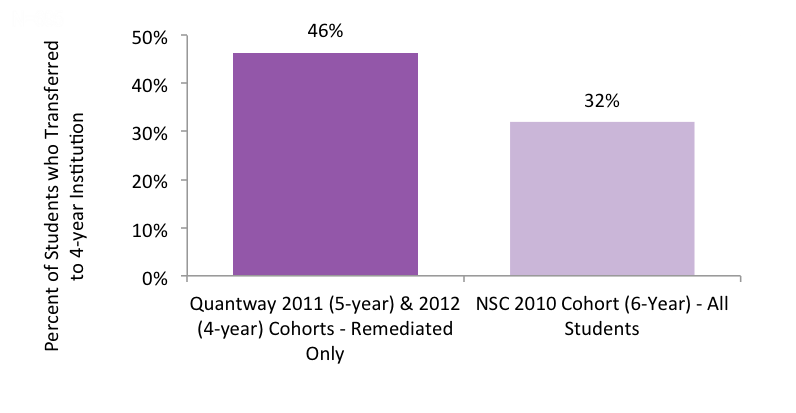
Norman, J. (2017). Pathways Post-Participation Outcomes: Preliminary Findings. Stanford, CA: Carnegie Foundation for the Advancement of Teaching.





